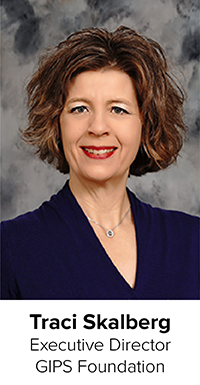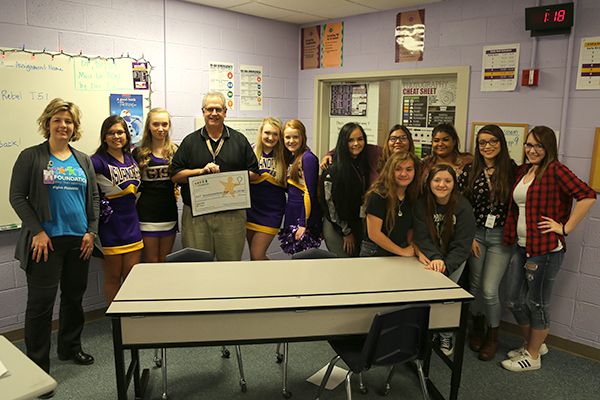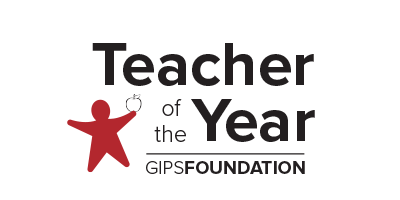
Volume 3 | Number 2
Welcome to Rise

Welcome to the March 2018 edition of Rise Grand Island the alumni newsletter for Grand Island Senior High published every other month by the Grand Island Public Schools Foundation. Rise is where we connect with thousands of Islanders across the globe, keeping you and them informed on what’s happening in Purple and Gold land, and reminiscing a little bit as well.
This is Volume 3, Number 2, the second edition of Rise this calendar year, our third year as the official publication for alums of Islander Nation. Thanks for reading us and for your comments and support.
We really enjoy hearing from those of you who find Rise in your in-box every other month. Give us a shout, especially if you or a GISH alum you know has done something new, newsy, or newsworthy. You can reach us at alumni@gips.org.
Our At the Top is proudly dropping names, specifically one name, the name of this newsletter — Rise, Grand Island — taken from the school song and now used by the entire school district and even a new television show about … you guessed it, a high school.
Also in the issue Foundation Executive Director Traci Skalberg announces the second “Decade Challenge” among the GISH graduating classes during Go Big Give scheduled for May. Last year your generosity and competitive spirit raised enough money for our Purple and Gold Fund to underwrite two grants that help GISH students. The Decade Challenge’s defending champs: The graduating classes from the 1970s.
Our Class Reunion Update let’s you know who is going to party and when in case your class is on deck or maybe you just want to crash another class’s soiree and see a few old friends.
Our From the Island correspondent Taylor Keyes gives us an insider’s view of the ACT — its stresses, necessities, and value.
Our Distant Mirror correspondent — and my good friend, fellow columnist, Olympic teammate — Mike Monk, Class of 1967, shares his lifelong love of the Olympics, including our own version the Big Games in the neighborhood the two of us grew up in.
My I’ve Been Thinking column focuses on the soundtracks of our generations. As a lover of music and unrepentant shower and vehicle crooner, nothing brightens memory like a favorite song from the past.
As we do every issue, we honor those Islanders who passed the last couple months in our In Memoriam section.
Per our custom, we’ll see what songs were popular on the radio, what movies were wooing us to the big screen, and what television shows kept us from our homework each decade during January going back to the 1930s.
We hope you enjoy this Rise as year three moves the cusp of spring. Oh, yeah, and remember … keep pushing on.
George Ayoub, Class of 1968
Editor, Rise Grand Island

At the Top
What's In a Name is Plenty
When this newsletter was looking for a name, we tried out three possibilities, two of which escape me now. We ran the trio past a number of potential readers, a small sample size primarily of Senior High alums, but not exclusively. Everyone we talked with was a member in good standing of Islander Nation, so we were confident in our research. Well, as confident as you can be after surveying only about a dozen well-situated people. Still, “Rise, Grand Island” was the clear cut choice.
Our alumni newsletter proudly wears that moniker even though we at the Grand Island Public Schools Foundation and many readers simply call it Rise, brevity being the soul of wit — and convenience.
Obviously we tapped into the last verse of the school song to name the newsletter:
“Rise Grand Island, We’ll always stand by you;
Go Grand Island, we will ever cheer and sing for
You to win Grand Island, our hearts will ever yearn
For the purple banner waving high for Grand Island!”
Islanders everywhere also know that the proper protocol and decades-long tradition during this stretch of the song is to stand and sing along, usually accompanied with unison, rhythmic clapping.
We’re happy to call ourselves Rise, Grand Island, so when the school district chose Rise Grand Island as a rallying cry this year and includes #RiseGI on hundreds of tweets, we like the sentiment.
Those dedicated education professionals who traffic in the phrase and hashtag are often on the front lines of changing the lives of the students who call GIPS home —a place we hope they can find opportunities, chase dreams, and yes indeed Rise!
I also ran across the name of a new series on NBC starting this month about — you guessed it — students at a high school, urged and supported to find opportunities, chase dreams, and yes indeed Rise! Which is also the name of the show, Rise.
Those of us here at Rise welcome anyone who shares our energy and our name and most important gets the idea of Rise, which, according to a 71-year old football program, comes from the name of the aforementioned school song: “Push On.”
Moving forward (in “word and deed”), staying strong (“when the game goes hard”), and pushing on (for all our victories) past and yet to come.
So, yeah, it’s called Rise … for all the right reasons.

I've Been Thinking
The Soundtrack of Our Lives

A good morning commute to Grand Island Senior High included music, an a.m. station blasting from the car radio. I lived about a “Light My Fire,” “Hello, Goodbye,” Judy in Disguise,” combo from school if the timing was extraordinary and my ride didn’t speed. (Which he did more often than not.)
Music — our music — filled our teenage souls, soothing (or abetting) our teenage angst, getting us out on the dance floor, and laying down psychic markers that have lasted me a lifetime.
I’m at an age some associate with memory lapses — senior moments they call them. Sure, OK, a face or a name escapes me now and then, and my car keys have lost themselves before.
But let the Box Tops (“Gimme a ticket for an aeroplane/ain’t got time to take a fast train/lonely days are gone/ I’m a-goin home/my baby, just wrote a letter”) come up on my car radio’s 60s station or maybe the Association (“Who’s tripping down the streets of the city/smilin’ at everybody she sees/Who's reachin' out to capture a moment/everyone knows it's Windy”) and every word floods back in perfect order and harmony. The lyrics to those two songs came to my keyboard just now without me checking lyrics.com. I don’t need its services because I was there, dude.
Music truly is the soundtrack of our lives, a seemingly lyrical signpost in our memories that remain there, anchored by rhythm and rhyme and repetition. Even the scientists and the medical profession are singing that song. Research from the Mozart effect to the use of music in treating dementia patients underscores the power of music in our memory.
Some memories go further than knowing the lyrics or the tune. Certain songs can trigger deep and meaningful emotions of time and place as I’m sure many of you can recall exactly where you were the first time you heard a song that’s on your all-time top 10 playlist.
I truly enjoy researching the number one songs of the different generations for each issue of Rise, discovering the music and lyrics that accompanied Islanders’ stay at Senior High. Moreover, as my class prepares for its 50th reunion next June, we opted to pipe in songs from the 60s rather than have a live band. We’re digging Pandora who looks as though it will be able to deliver the music for us.
For kicks, I researched the Billboard Top 100 from the summer of 1967 to the end of May, 1968, to see what songs bubbled to the top in the year preceding our graduation, where we listened to speeches about our future and marched in and out to the strains of Elgar. But as far as “our” music went (Koo-koo-ka-choo Mrs. Robinson), these were the songs, chronologically, that topped the charts and touched our lives during that year.
“Groovin'" The Young Rascals
“Windy" The Association
"Light My Fire” The Doors
"All You Need Is Love” The Beatles
"Ode to Billie Joe” Bobbie Gentry
"The Letter” Box Tops
"To Sir With Love” Lulu
"Incense and Peppermints” Strawberry Alarm Clock
"Daydream Believer” The Monkees
"Hello, Goodbye” The Beatles
"Judy in Disguise” John Fred and His Playboy Band
"Green Tambourine” The Lemon Pipers
"Love is Blue” Paul Mauriat
"(Sittin' On) The Dock of the Bay” Otis Redding
“Honey" Bobby Goldsboro
"Tighten Up” Archie Bell & the Drells
"Mrs. Robinson” Simon & Garfunkel
I’m not sure whether it's a distinction or disability that 50 years later I still know nearly every word to each of these songs — and sing them at the top of my lungs alone in the car. And when you’re bellowing solo in your vehicle and a word or phrase doesn’t come to you … well … do what I do. Make it up or mumble. They both work. Hey, we’re still arguing over the social implications of the muddied and overly-examined lyrics to “Louie Louie.”
Nor am I stuck in the 1960s. My iPhone is filled with music from every genre and almost every generation — all fair game on long road trips, my own Carpool Karaoke, without the cameras and other singers.
Still, something remains particularly special about the music from our youth, our high school days, when change and energy and awkwardness and new friendships and, yes, rebellion were afoot. But most of all, music reminds us of the pure joy of being young and alive, sure that all we needed was love to light our fires, groovin’ and daydream believing, there by the dock of the bay.

Alumni Reunions
Planning a class reunion?
We can help get you started!
Contact us for your class list and send us information about your reunion. We will post it to our website.
Kari Price, Alumni Coordinator
kprice@gips.org
308.385.5900 ext. 1148

NOTE: Reunion information in this newsletter is current as of the publication date. To see Reunion updates and additions go to our Alumni Reunions page.
Class of 1951
The class of 1951 will hold their bi-annual reunion at the Liederkranz on Friday, October 5th, 2018, Harvest of Harmony weekend. Please contact Jim Marsh for details at (702)946-1000.
Class of 1956
The Class of 1956 wishes to extend an invitation to fellow classmates to join them at their monthly gathering. They meet on the 2nd Tuesday of each month at the Midtown Holiday Inn at 6:00 pm. For more information please contact Ed Felske at (308) 382-3111.
Class of 1966
The Class of 1966 wishes to extend an invitation to fellow classmates to join them at their monthly lunch gathering. They meet the 3rd Wednesday of each month at the Platt Duetsche at 1:00 pm.
Class of 1968
The Class of 1968 will hold its 50th Reunion on June 22-23, 2018. Both nights will be at Riverside Golf Club. The cost for the weekend is only $50 a person including dinner each night. ($60 after May 1) A class booklet with information and addresses of classmates is also available for $10. Check out and like our Facebook page — “GISH Class of 1968.”
Registrations should be sent to Class of ‘68 50th Reunion, PO Box 5201, Grand Island, NE 68802. Make checks payable to Class of 1968. Be sure to include the additional $10 if you want a booklet. Please include a short (100 words or so, at most) newsy “update” on your life and include any contact information you want to share: phone, address, email, social media. Tours of Senior High will be available at 10 a.m. on Saturday June, 23.
Questions should be directed to kbbart@charter.net or via Facebook.
Class of 1998
The Class of 1998 will hold its 20th Reunion the weekend of July 13-15, 2018 with the main event on Saturday evening at Kinkaider Brewery. Join our Facebook group “Grand Island Senior High Class of 1998” for the latest reunion details and to reconnect with classmates. Any questions can be emailed to gish98@gmail.com.
This information and more is also available at: https://is.gd/Nrawsb.
Class of 2008
The Class of 2008 will hold its 10th Reunion Saturday, June 9th, 2018. There will be yard games from 11:00-3:00 at the GISH practice field. A tour of GISH is scheduled at 1:30. Saturday evening will be a gathering at Infinity Lounge at Boarders Inn and Suites from 7:00 - 10:00. For more information, contact Vanessa Gauthier at vgauthier@cmsd12.org.
Shaking the World
Go Big Give With the Purple and Gold Fund

Last year we established a fun little contest in conjunction with Grand Island’s Day of Giving, Go Big Give. We challenged alumni to participate with us in the online giving day to establish the Purple and Gold Fund. We also kept track of the decades as gifts rolled in to see which decade could claim the “oh so sought after” street cred. While George was confident that the 60’s would win, the 70’s came in with their sleeves rolled up and ready to rumble. Even though the 70’s won the street cred, seven decades were represented. That is very impressive. In all, alumni gave over $8,000 that day. $2,132.75 was unrestricted and therefore designated to the Purple & Gold Fund.
The GIPS Foundation gave away two classroom grants this year that were funded with the Purple & Gold Fund. The grants were awarded for two projects at Grand Island Senior High, “Outdoor Classroom,” and “Senior High Photography Club.” A detailed description of these grants is available in the Your Legacy. Their Opportunity. Section.
Let’s do this again!
On May 3, 2018, the GIPS Foundation will again participate in Grand Island’s annual day of giving. This is online giving day makes it easy for anyone in the world to give to their favorite Grand Island charities. All gifts from alumni who give to the GIPS Foundation through the Go Big Give platform will be credited to the Purple and Gold Fund. This fund will be used to offer grant opportunities to fund programs, projects and scholarships that benefit individual students, classrooms of students, or the entire campus/district. When awards are made from this fund, this newsletter will feature them.
Decade Challenge
Just to make sure that other decades get a crack at this “Street Cred” thing, we will offer the decade challenge again. We will record how many gifts and how much was raised for the Purple and Gold Fund by decade. So, if you are a member of the class of 1956 for example, your gift will be attributed to the 1950s decade.
QUESTIONS AND ANSWERS
If my decade has the most gifts or gives the highest amount, what do we get? The answer is street cred. We will highlight the decade winners in the May newsletter and give your decade the coverage it deserves.
How will you know who belongs to which decade? When you give to the GIPS Foundation through Go Big Give, we get a list of donors. We will match this list with our database and credit the proper decade. Please be sure to list your name as you give to Go Big Give. If you give anonymously, we don’t get your identifying information, and therefore would not be able to credit the gift to your decade.
Can I send a check instead? Yes, but to be credited to this challenge, your check needs to be made out to Go Big Give and sent to our office by April 24. Our office address is: GIPS Foundation; PO Box 4904; Grand Island, NE 68802. The physical address is 123 South Webb Road.
How do I give? The Go Big Give online portal will open for pre-giving on April 26. The day of giving is May 3. The direct link to the GIPS Foundation Go Big Give page is: https://www.gobiggive.org/index.php?section=organizations&action=overview&fwID=53
We will send a reminder e-mail blast on April 26 and again on May 3 with this link.
Why are you asking alumni? We could really use YOUR help with this effort. Charities that participate in the Go Big Give campaign are eligible for prizes and matching gifts based on number of unique givers, total dollars raised, and number of gifts raised per hour. Talk about a way to broaden our impact! We know there is power in numbers. This Go Big Give Day maximizes the collective impact concept to generate real dollars that in our case, translate into opportunities for the 9,700 students who attend our schools. We are excited to participate in such an impactful fundraiser.
5,497: the number of alumni receiving this e-mailed newsletter. Just think about the results, if YOU and each of your fellow 5,496 alumni and friends gave $10 or more to the GIPS Foundation through the Go Big Give effort. The collective impact of your gift, not counting the matching gifts or prizes earned that day would add up to $54,970 for students! That is 100 more scholarships, or 50 more grants, or 200 more individual opportunities funded. It would be amazing to see this number. We want you. We need you. We hope that you will consider the power of your gift to students.
Your Legacy. Their Opportunity.
2017-18 Purple & Gold Fund Grants
Thanks to your support, the following projects were funded through the Alumni Purple & Gold Fund.
Reneé Ekhoff, Grand Island Senior High, $1,300, “Outdoor Classroom and Field Trips”. This grant will be used to enhance the learning of students in the GISH Environmental Science class and the Roots N Shoots program. The grant will be used to update the outdoor classroom with self-sufficient, minimal maintenance watering systems (using rain barrel recycled water), native species identification plates, and introducing native species of flora into the area. Students who are involved in these two programs will also have the opportunity to attend conservation and wildlife, ecology and environmental studies field trips at Native Prairies with Prairie Plains Resource Institute. The field trips will include Crane Trust Nature and Visitor Center, Gerloff Prairie and Sherman Ranch with guest speakers and hands on experiences. This grant will benefit 60 students in grades 9-12.

Roger Holsinger, Grand Island Senior High, $1,200, “Senior High Photography Club”. The Photography Club at Grand Island Senior High School is in need of digital cameras. Currently, students in the club must have their own SLR in order to participate. This grant will be used to purchase two (2) Canon digital cameras to be used by students in the club. This grant will benefit 20 students in grades 9-12.

On the Island
News From the Halls of Senior High

Standardized tests have been around for decades. These tests aim to examine the intellectual abilities of students based upon a range of common academic subjects.
For years, juniors took the Nebraska State Accountability (NeSA) test. My class, class of 2018, was the first to take the ACT as juniors on the national level. On April 19, 2017, all juniors across America took this test cost-free in place of previous state assessments.
Why the change? Because of the passage of LB 930, a bill that establishes the administration of a standard college admission test at the high school level by 2017-2018, juniors now take the ACT. Since my class was the first in this transition, our scores were a field test for CCRS (College and Career Ready Standards), the first part in the two year process.
Since the ACT is such a widely recognized, college admissions exam, it was the best option. The Nebraska standard test, previously known as NeSA (Nebraska State Accountability) is now NSCAS (Nebraska Student-Centered Assessment System).
As someone who has personally struggled to reach my goal score, I understand how frustrating these tests can be. Administrators, teachers, parents and students have long asked, “Why take standardized tests?” How accurately do they really measure proficiency?
The ACT surely does not always represent a student’s capabilities. Many factors contribute to score outcomes, a lot more than just a person’s general understanding of core subjects. Standardized tests are flawed measures of intelligence that measure different qualities for different students, depending purely upon how their score was reached. Level of preparation, desire for improvement, and fast test taking ability are all subjects of this composite score by which students across the nation are classified.
Yes, high scores on the ACT may stem from a superior level of hardwired intelligence and a promising education, but they may also stem from rather average innate intelligence in conjunction with extensive prep work. A student’s level of preparation can change his or her scores dramatically. Prep courses, tutors, practice tests, and other forms of study material are easily accessible to many students. Those who take advantage of easy opportunities to learn the content of the test, as well as time-saving strategies, will generally score higher against someone who did not complete any preparatory work.
I improved my composite score by three points just from enrolling in a prep class, reviewing basic content and incorporating learned strategies into my performance. Because it is possible to improve one’s score immensely by committing time to preparatory efforts, it is clear that this “basic intelligence” test is a bit faulty.
The ACT is a developed alternative to the SAT: a test that was originally derived from an IQ test that examines overall subjective reasoning ability. The goal of the ACT is to test school-based material that is learned in the classroom. This means that the quality of one’s education is also a factor in the outcome of their scores. Social inequalities hurt impoverished students, even when intelligent, because of the quality of education with which they were provided. Two students with relatively equal intelligence but differing education conditions may earn completely opposite scores. Prep materials, tutors, etc are also a lot less accessible to those in undeveloped school systems, giving them even less of a chance to reflect their potential in their scores.
A student’s ACT scores are also subject to his or her desire for improvement, overall academic ambition, and understanding of its importance. The ACT is supposed to measure college and career readiness; it is also one of the crucial qualifying factors of academic scholarships. Students who understand the stakes behind this test generally perform better and have more drive to improve when dissatisfied, even when put at a disadvantage.
If the ACT were to accurately reflect personal intellectual ability, many would be pulling more consistent scores, but because this exam tests so many different qualities, several high school students are unhappy with their results, taking the test over and over. Personally, perfectionism handicaps my ability to take tests in a timely manner: something that is important when taking the ACT.
Overall, there is definitely a significant lesson to be learned about standardized tests: They do not define who you are or what you are capable of accomplishing in the future. Your score is merely a number that will decide how much you will pay for your college education, or rather how much you will not pay. It is a limited measurement of specific academic performance, and does not paint the picture of your potential. Scores can be a useful benchmark tools for applying to colleges, but they do not define who you are or the power you carry. Too many factors go into the final result of a test score to determine one’s intelligence based upon that number itself.

A Distant Mirror
The Olympics

My daughter recently posted on Facebook a picture of my five-year old grandson Leonardo and me, in our seats at a Minnesota Wild hockey game. Her comment, referring to her son and father, was, “The two most sports-obsessed people I know in their natural habitat.” I proudly plead guilty to the charge. Sports has always been a joy for me and not the least among my sporting passions is the Olympics.
I first became enthralled with the Olympics in 1960, at age 11, when watching the Rome Olympics on the black and white television. I thrilled to the feats of the outrageous and completely likable Cassius Clay, the willowy speedster Wilma Rudolph, and the decathlete Rafer Johnson. These were a watershed Olympics, as is well chronicled in the recent book, “Rome 1960, The Olympics That Stirred the World,” by David Maraniss.
In early September of 1960, just following the completion of the Rome Olympics, my friends and I created our own “Neighborhood Olympics.” Most of the events occurred at Randy Spiehs’s house and the vacant lot across the street on 13th and Elm, just north of Howard School. Randy and I, and our buddies George Ayoub, Craig Johnson, Mike Parmley, Van Coker, and Billy Murphy, and others I don’t recall precisely, all participated. We had a 100-yard dash and a 400-yard race around the block. In the vacant lot we built a high jump and pole vault by putting a couple of 2 by 4 uprights in the ground, with nails in them to hold the bamboo cross bar. We held the high jump and the pole vault, using a bamboo vaulting pole. Fascinated by the techniques in the shot put, I had earlier that year bought an 8-pound shot put from Russell Sports, and we used that for the shot put. As it turned out, my buddy George Ayoub later became the shot put star at Walnut and Senior. I also seem to recall we used a old hub cap for a discus. We also held bike races around the block.
Around this time, when I was 11, I also recall mentally calculating whether I would be a senior in college in an Olympic year, since I knew it would be easier to make the Olympic basketball team as a senior, and that was clearly what I intended to do. I calculated that, alas, the Summer Olympics would be in 1968, when I was a college sophomore. Ah, sweet youth and sweet innocence.
My love of the Olympics never waned, and I was fortunate enough to attend in person both the Los Angeles Olympics in 1984 and the Sydney Olympics in 2000. At each of these two Olympics I splurged on track and field tickets, attending most evening sessions. In Los Angeles, I was able to see Joan Benoit at mile two of the marathon, which was on San Vincente Boulevard, a block and a half from our home in Santa Monica. Benoit won the Gold Medal in the first ever Olympic women’s marathon. I was also was able to see such stars as Carl Lewis, Sebastian Coe, and Mary Decker.
In Sydney, on Monday, September 25, 2000, I saw Michael Johnson win the 400 meter Gold Medal, and, the famous indigenous Aussie, Cathy Freeman, win the Gold Medal for the home country in the women’s 400 meters. On that same September 25 night, I saw British jumper Jonathan Edwards win the men’s triple jump, saw the first ever women’s pole vault competition — won by American Stacy Draggle — and watched a classic 10,000 meter race won by Haile Gebrselassie of Ethiopia over Paul Tergat of Kenya, in a photo finish. Later, the Bud Greenspan documentary of the Sydney Olympics called this night, “The greatest night in track and field history.”
As the years passed I became more aware that politics often tainted the Olympics and made it less pristine. I was upset when the USA boycotted the 1980 Moscow Olympics (How could Carter strip athletes of the chance to participate, when many had been preparing their whole lives for this event?). I was also annoyed when the Russians then boycotted the 1984 Olympics.
But wonderful stories continued to occur in the Olympics, including the Franz Klammer downhill victory in 1976, the 1980 Miracle On Ice hockey game when the USA upset the heavily favored Russians, the dominance of Eric Heiden and Bonnie Blair in speed skating, and a hundred more. And the addition of the snow boarding events brought a new exciting sport to the Winter Olympics.
So I was ready for this year’s Winter Olympics in South Korea. I have found that I don’t really get excited until the competition begins, and then I become hooked. This year’s Olympics, like most, had troubling political issues, but I think it was an inspiring Olympics.
The International Olympic committee purportedly banned Russia from these Olympics, since the IOC found that Russia had systematically engaged in doping, and changing test samples. That certainly merited a ban. But it soon became clear is was not much of a ban. One hundred and sixty-eight Russian athletes were allowed to compete. While they could not use the Russian flag, they wore red, marched in as a team in Opening Ceremonies, were allowed to have teams in hockey and other sports, and were listed as a team in the medal standings. While I had assumed the individuals would be referred to as something like “Unaffiliated Olympic Athletes,” the team was called “Olympic Athletes From Russia.” Some punishment. That name is as ridiculous as the name of baseball’s “Los Angeles Angels of Anaheim.” And to top it off, two of the “Olympic Athletes from Russia” tested positive for banned substances in South Korea.
But the Russians aside, these Olympics came off quite well I think. I loved the fact that Norway, a less populous country, topped the medal standings. I loved that a snow boarder, Ester Ledecka, was the surprise winner in the Super G Alpine event, and was in such disbelief, she thought the scoreboard made a mistake. I enjoyed the commentary of Mike Turico, Tara Lipinski, and the flamboyant Johnny Weir. I looked forward to the Biathlon, the blend of cross country skiing and shooting. Someone said the Biathlon is like running a marathon and then, with heart pounding, having to thread a needle. My grandchildren would get down on the floor and pretend to shoot, then, if they missed, go around the room pretending to ski the penalty lap.
But there were several wonderful moments in these Olympics that brought me great joy, great emotion and a few tears, including the following:
1. Shaun White
The most dominant snow boarder in history, with Golds in the half pipe in both the 2006 and 2010 games, White is the Godfather of Snow Boarding. But White did not medal in the 2014 games and it looked like he might never again be on the podium. Also, just this past October, he had a horrific training accident that required over 20 stitches in his face, and put him in the hospital for a long stint. But here he was, more measured and wiser than before, sounding actually quite intelligent, trying to recapture the magic at age 31. In the final, he produced a terrific run that put him in first place going into the final runs. A dream come true. But a very talented Japanese boarder, Ayumu Hirana, then pulled off a spectacular run to take over the lead on the next to last run of the entire competition. White was now in second place with only one run left. But on his last run, under immense pressure and with no room for any glitch, he produced a run for the ages, with high degree of difficulty and flawless execution. He had won the Gold Medal on his last run. Then we saw him immediately overcome by emotion, breaking into tears. He found his mother and hugged her, sobbing like a baby. I was thrilled and stunned by the magnificent performance, and I soon found myself a bundle of tears.
2. Lindsey Vonn and Mikaela Shiffrin
Lindsey Vonn has dominated Alpine skiing and the World Cup circuit for over a decade. She now has more World Cup victories than any woman in history. At age 33, she was clearly in her last Olympics, and despite a nice run, finished third to win the Bronze Medal in the Downhill, her signature event. In her post race interview, she poured out her heart’s deepest feelings, expressing love of the competition and her sadness that this would be her last Olympics. She said she hoped her recently deceased grandfather would be proud of her Bronze Medal this last Olympics, and began to sob. And of course I began to cry also. I wanted to tell her, “Lindsey, you have been an amazing athlete who has dominated your sport and you have now have medaled in the Downhill at the geriatric age of 33. You are the best female Alpine skier the world has ever seen. Of course your grandfather would be totally proud of you!”
Twenty-two year old Mikeala Shiffrin is the new Alpine legend, and she has stunned the World Cup circuit by winning most of the slalom races in the last three years. She also was very open and emotional in her interviews, expressing her love for the Olympics and her anxiety before races, often throwing up before a race. She did very well, winning Gold in the Giant Slalom, and the Silver in the combined Alpine event. But in her specialty, the slalom, she finished fourth, not making the podium, and was crushed. But the next day, she posted a message saying essentially that while sometimes you win and sometimes you lose, the joy is being able to be part of such a wonderful competition and all the high stakes that are part of it. A very gracious remark from a wonderful young woman.
3. The USA Women’s Hockey Team
Women’s hockey in the Olympics has been dominated by the Canadians and the Americans. But after the USA won the gold in 1998, Canada won the next four Golds, in 2002, 2006, 2010 and 2014. The USA lost a heartbreaker in 2014, leading 2-0 in the Gold Medal game, but seeing the Canadians come back to beat them.
Both Canada and the USA made it to the Gold Medal game, and it was one of the best hockey games I have ever seen. Played with skill and passion, it was a nail biter. After the USA scored first, Canada scored two goals in the second period to go up 2-1. The third period was fascinating with both teams coming close to scoring and the tension palpable. Finally, with less than 10 minutes to play, the USA scored to tie the game at 2-2. After no scoring in the 20 minute sudden death overtime, the game was then decided on penalty shots. As individual women took penalty shots, each was painfully important, since any one shot could mean a Gold Medal. Tied after the required five shooters, the shootout also went overtime. On the sixth shooter, which now was sudden death, the USA’s Jocelyne Lamoureau-Davison scored on an amazing shot involving three different fakes, to put USA up by one. Now it was up to our 20 year old goalie, Maddie Rooney to stop the final Canadian shooter cold, and she did. USA wins!
The game was so close and tense that at the end, I jumped up, shouted and thrust my fists in the air. I am told I was not the only one to do so. Then you saw an overwhelming scene of high emotion, with women on both teams in tears, tears of sadness for Canada and tears of joy for the USA. This sparkling game alone made this Olympics a resounding success for me.
4. USA Men’s Curling
For the first time ever, I paid serious attention to the curling, and I learned a bit more about it. The USA men’s Gold Medal was perhaps the biggest upset of the Olympics. The team had performed horribly at the 2014 Olympics, and were dropped by the USA federation that supports curling teams. But these men continued on their own dime, and surprised everyone by making it back to the Olympics in 2018. After a horrible start this year, losing 4 of their first 6 games, they found magic. They won three straight matches to make the medal round, and then won the last two games to grab the Gold Medal. A group of men in their 30’s from Minnesota and Wisconsin, they did not appear particularly athletic, indeed a bit frumpy. But they played with extraordinary skill. To see them singing the National Anthem with gusto at their Gold Medal ceremony was a joy.
5. Jessie Diggins and Kikkan Randall
My final feel good story was Jessie Diggins’s and Kikkan Randall’s Gold Medal in the women’s cross country skiing team sprint. This was the first ever Olympic medal for the USA in cross country skiing. The finish was also mesmerizingly close. Diggins come from third place in the last 200 meters, passed the other two teams, and crossed the line about a foot ahead of her nearest opponent. Once again, joy and tears erupted. The entire women’s cross country team made a name for itself even before the Gold, with their smiles and spirited embrace of the Olympics. Diggins was chosen to be the flag bearer for the USA in the Closing Ceremonies, and she could not stop smiling.
So farewell Olympics for a couple of years. Many of this year’s memories will stick with us for some time.
Mike can be reached at m.monk@mpglaw.com.
In Memoriam
January and February memorial list of GISH Alumni
RAY REUTLINGER, Class of 1945, died Dec. 30, 2018, in Salem, Ore. He was 90.
DANA MORA, Class of 1996, died Jan. 1, 2018, in Arlington, Texas. He lived in Grand Island. He was 39.
JEAN (NIELSEN) MASSEY MCELROY, Class of 1949, died Jan. 5, 2018, in Grand Island. She was 86.
DUTCH SCHWIEGER, Class of 1956, died Jan. 6, 2018, in Grand Island. He was 80.
JEFFREY WILSON, Class of 1957, died Jan. 7, 2018 in Fort Worth, Texas. He was 79.
JUDY JO (ROBY) WIEGERT, Class of 1960, died Jan. 11, 2018, in Lincoln. She was 76.
DONNA (DABERKOW) LARSON, Class of 1943, died Jan. 14, 2018, in Brookings, S. D. She was 90.
CHERYL (BERNTH) RUGEBREGT, Class of 1966, died Jan. 15, 2018, in Lincoln. She lived in Grand Island. She was 69.
JOYCE (FRIEDRICHSEN) OGDEN, Class of 1963, died Jan. 16, 2018, in Cozad. She was 73.
LEON ROBY, Class of 1963, died Jan. 17, 2018, in Grand Island. Leon lived in Alda. He was 72.
ROBERT “BOB” NEUMAYER, Class of 1949, died Jan. 18, 2018 in San Diego, Calif. He was 86.
JAMES “JIM” SCHWIEGER, Class of 1959, died Jan. 20, 2018, in Whitney, Texas. He was 76.
JADEN VALDERAZ, Class of 2010, died Jan. 21, 2018, in Omaha. Jaden lived in Grand Island. He was 25.
JOE HOSTLER, Class of 1984, died Jan. 22, 2018, in Orlando, Fla. Joe lived in Lititz, Pa. He was 51.
JUNE ( MEYER) QUAIFE, Class of 1972, died Jan. 22, 2018, in Omaha. June lived in Grand Island. She was 63.
EVELYN (STELK) STARKEY, Class of 1940, died Jan. 25, 2018, in Grand Island. She was 94.
DR. C. DEAN MCGRATH, Class of 1942, died Jan. 26, 2018, in Grand Island. He was 93.
JERRY SEVY, Class of 1958, died Jan. 29, 2018, in Grand Island. He was 77.
ALLEN HERMAN “AL” ZIKMUND, Teacher and coach at GISH, died Jan. 29, 2018, in Kearney. He was 95.
DWAYNE “SARGE” SARGENT, Class of 1959, died Jan. 31, 2018, in Goodyear, Ariz. Sarge lived in Buckeye, Ariz. He was 77.
ARLENE (WILSON) FEYEN, Class of 1953, died Jan. 31, 2018, in Atchison, Kan. She was 82.
EFREN CABRERA, Class of 2005, died of Feb. 1, 2018, in Grand Island. He was 31.
DEBRA (LEACH) SKINNER, Class of 1989, died Feb. 1, 2018, in Omaha. Debra lived in Grand Island. She was 47.
MICHAEL HANN, Class of 1968, died Feb. 4, 2018, in Fairmont. He was 67.
CLIFFORD FRYMIRE, Class of 1944, died Feb. 10, 2018, in Grand Island. He was 92.
WILLIAM LAWREY, SR., Class of 1946, died Feb. 18, 2018, in Grand Island. He was 88.
JOY (RENTER) ECKLES, Class of 1963, died Feb. 18, 2018, in Seward. She was 73.
ROBERT MERTON SR., Class of 1957, died Feb. 18, 2018, in Orcutt, Calif. He was 78.
GALE ANN (KROLL) FUQUA, Class of 1964, died Feb. 19, 2018, in Wood River. She was 71.
PATRICIA (PARSONS) STALKER, Class of 1945, died Feb. 24, 2018, in Grand Island. She was 89.
STEFFANIE ROACH, Class of 1983, died Feb. 26, 2018, in Lincoln. She was 53.
To report an alumni death since February 28, 2018, please send an email with the first name, last name, class year and maiden name if applicable to alumni@gips.org











